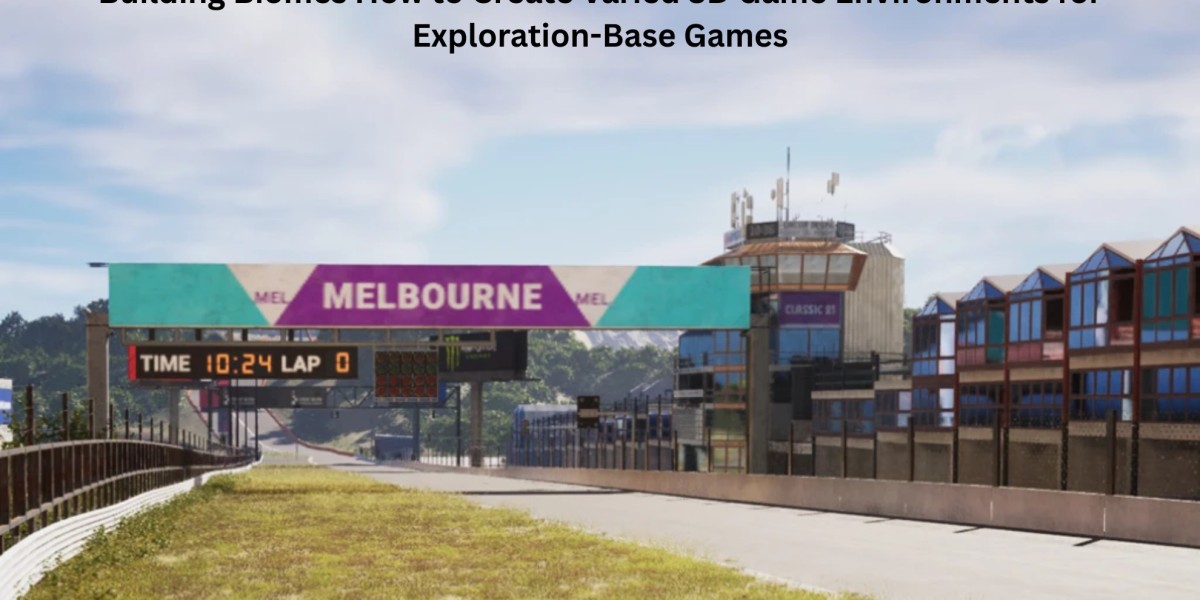In the expansive world of exploration-based games, the key to player engagement often lies in the environment. A rich and varied biome system—deserts, tundras, forests, swamps—provides more than visual appeal; it fuels discovery, strategy, and immersion. To make this happen, game developers must harness the full power of 3D modeling games technologies and tools. From modular design to 3D game assets, and 3D hard surface modeling to texturing terrain transitions, every aspect of a biome must be carefully constructed.
Understanding the Role of Biomes in Exploration-Based 3D Game Environments
Exploration-based games thrive on curiosity. Whether it’s uncovering a lost city in a jungle or navigating treacherous icy peaks, the 3D game environment must constantly reward exploration. Biomes make this possible by providing a sense of diversity and progression.
Creating distinct biomes requires deep knowledge of 3D environment modeling. Terrain features, lighting, flora, fauna, and atmospheric effects must change fluidly to keep players immersed. Players are more likely to continue playing when they’re visually and tactically stimulated by unique environments that push them to explore further.
3D Modeling Games: The Foundation of Biome Design
3D modeling games demand more than pretty visuals. Developers use powerful engines like Unreal or Unity in tandem with modeling software such as Blender, Maya, or 3ds Max to bring these worlds to life.
Building Essential 3D Game Assets for Biomes
Each biome needs specific 3D game assets—trees for forests, cacti for deserts, and coral reefs for underwater zones. The trick lies in balancing variety and optimization. Too much variation strains performance, while too little can bore the player.
Smart developers create modular props 3D models, such as rocks, logs, or ruins, that can be reused across multiple environments with minor modifications. Asset libraries must include:
Terrain props 3D models (e.g., logs, bushes, bones)
Ambient detail models (e.g., mushrooms, fallen leaves, puddles)
The use of Level of Detail (LOD) models also ensures that distant objects don’t consume unnecessary resources, maintaining performance while preserving visual fidelity.
3D Environment Modeling: Creating Seamless Biome Transitions
An overlooked challenge in biome creation is the transition between ecosystems. 3D environment modeling must address biome blending.
This is where tools like vertex painting, dynamic terrain blending, and environmental decals become essential. For instance, the edge of a desert might gradually introduce dry grass patches before fully transitioning into savannah terrain. Water zones may use semi-submerged assets and fog volumes to create a believable shoreline.
Lighting and weather also play crucial roles. A thick jungle biome should be dimly lit with heavy fog and filtered light, while snow-capped mountains can leverage bright sunlight, reflective snow shaders, and crisp shadows to convey harsh conditions.
Leveraging Hard Surface Modeling for Environmental Structures
While organic elements dominate most biomes, exploration games often include architectural or mechanical features—ruins, bunkers, gates, and bridges—that require Hard Surface Modeling.
This style of modeling is ideal for rigid, man-made elements and adds contrast within natural surroundings. For example, players stumbling upon a car 3D model buried in the sands of a post-apocalyptic desert instantly receive visual storytelling. Similarly, weathered bridges or pipelines built using 3D hard surface modeling can be used to navigate gorges or rivers.
Hard surface props offer visual and gameplay variety. Think of an abandoned train cutting through a jungle or an underground lab beneath an arctic wasteland.
Car 3D Model and 3D Vehicle Modeling in Biomes
Vehicles serve as exploration aids and storytelling tools in open-world games. Designing them requires a blend of realism and creativity. A car 3D model isn't just for racing—it might be an abandoned relic, a travel method, or a mobile safe house.
In 3D vehicle modeling, it’s important to match the biome. Snowmobiles in tundras, amphibious jeeps in swamp zones, or solar-powered rovers in deserts—each must feel like it belongs.
Optimization is key. Many games even animate interior components for added immersion.
Props 3D Model Creation: Filling the World with Interactive Detail
Small details make or break biome realism. A well-modeled props 3D model—a broken signpost, a lantern hanging from a tree, or bones half-buried in snow—adds depth and mystery.
Props should align with biome logic and narrative. For instance:
Desert biome: cracked pottery, ancient tablets, sand-swept machinery
These elements aren’t just decorative—they hint at past events, guide the player subtly, or mark points of interest. Designers often incorporate storytelling directly into props, using them to build environmental lore without dialogue.
Performance Optimization in Large 3D Game Environments
One of the biggest challenges in 3D modeling games is managing performance across expansive biomes. Here are some optimization strategies developers use:
Modular 3D game assets for repeatable structures
Texture atlases to reduce draw calls
Occlusion culling to hide unseen assets
Distance-based LOD for 3D game environments
Shader simplification for mobile or VR platforms
Efficient 3D environment modeling allows for larger maps, more biomes, and better visual diversity without compromising frame rates.
Tips for Designing Biomes That Drive Exploration
To maximize the potential of your 3D game environment, keep the player in mind:
Reward Curiosity: Hide secrets, collectibles, or story pieces in each biome.
Use Biome Logic: Creatures, buildings, and vehicles should feel like they evolved within the biome.
Story Integration: Let the environment hint at backstory—fossils in a cave, ruins in a jungle, wreckage in a frozen bay.
Conclusion: From Terrain to Texture, Biomes Shape the Soul of Exploration Games
Creating vibrant, immersive biomes is a cornerstone of modern 3D modeling games. With the right blend of 3D game assets, 3D environment modeling, and Hard Surface Modeling, developers can craft worlds that players don’t just play in, but truly explore. Whether you're building a car 3D model for desert traversal or placing the perfect props 3D model near a ruined castle, remember that every asset contributes to the experience.
As exploration-based games continue to dominate the market, studios that master biome creation will stand out with rich, believable 3D game environments that beckon players back for more.






